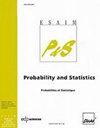A semi-implicit finite volume scheme for dissipative measure-valued solutions to the barotropic Euler system
IF 0.7
4区 数学
Q4 STATISTICS & PROBABILITY
引用次数: 0
Abstract
A semi-implicit in time, entropy stable finite volume scheme for the compressible barotropic Euler system is designed and analyzed and its weak convergence to a dissipative measure-valued (DMV) solution [E. Feireisl et al., Dissipative measure-valued solutions to the compressible Navier-Stokes system, Calc. Var. Partial Differential Equations, 2016] of the Euler system is shown. The entropy stability is achieved by introducing a shifted velocity in the convective fluxes of the mass and momentum balances, provided some CFL-like condition is satisfied to ensure stability. A consistency analysis is performed in the spirit of the Lax's equivalence theorem under some physically reasonable boundedness assumptions. The concept of K-convergence [E. Feireisl et al., K-convergence as a new tool in numerical analysis, IMA J. Numer. Anal., 2020] is used in order to obtain some strong convergence results, which are then illustrated via rigorous numerical case studies. The convergence of the scheme to a DMV solution, a weak solution and a strong solution of the Euler system using the weak-strong uniqueness principle and relative entropy are presented.正压欧拉系统耗散测度值解的半隐式有限体积格式
设计并分析了可压缩正压欧拉系统的半隐式时间熵稳定有限体积格式,并将其弱收敛到耗散测度值解[E]。Feireisl et al.,可压缩Navier-Stokes系统的耗散测度值解,Calc. Var.偏微分方程,2016]的Euler系统。熵的稳定性是通过在质量和动量平衡的对流通量中引入一个位移速度来实现的,只要满足一些类似cfl的条件来保证稳定性。在一些物理上合理的有界性假设下,利用Lax等价定理的精神进行了一致性分析。k -收敛的概念[E]。fereiisl等,数值分析中的k收敛新工具,[j]。分析的,[2020]是为了获得一些强收敛结果,然后通过严格的数值案例研究来说明。利用弱-强唯一性原理和相对熵,给出了该方案收敛于欧拉系统的DMV解、弱解和强解。
本文章由计算机程序翻译,如有差异,请以英文原文为准。
求助全文
约1分钟内获得全文
求助全文
来源期刊

Esaim-Probability and Statistics
STATISTICS & PROBABILITY-
CiteScore
1.00
自引率
0.00%
发文量
14
审稿时长
>12 weeks
期刊介绍:
The journal publishes original research and survey papers in the area of Probability and Statistics. It covers theoretical and practical aspects, in any field of these domains.
Of particular interest are methodological developments with application in other scientific areas, for example Biology and Genetics, Information Theory, Finance, Bioinformatics, Random structures and Random graphs, Econometrics, Physics.
Long papers are very welcome.
Indeed, we intend to develop the journal in the direction of applications and to open it to various fields where random mathematical modelling is important. In particular we will call (survey) papers in these areas, in order to make the random community aware of important problems of both theoretical and practical interest. We all know that many recent fascinating developments in Probability and Statistics are coming from "the outside" and we think that ESAIM: P&S should be a good entry point for such exchanges. Of course this does not mean that the journal will be only devoted to practical aspects.
 求助内容:
求助内容: 应助结果提醒方式:
应助结果提醒方式:


